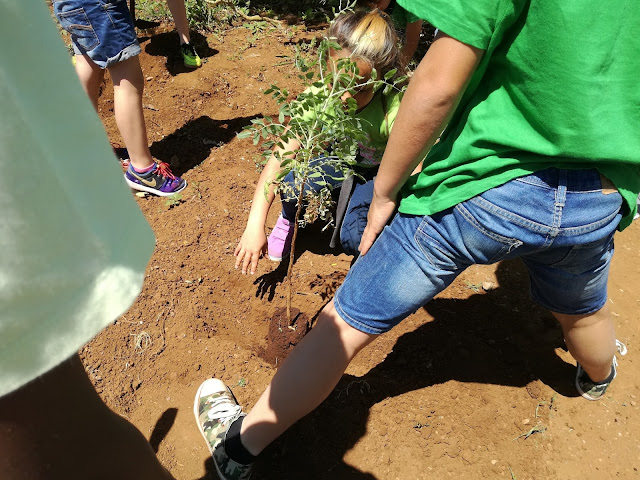Olá pásarinhos !!
Hoje vou falar sobre uma atividade muito curiosa e produtiva que realizamos
há algumas semanas como parte de nosso programa de educação ambiental nas
escolas: replantação de espécies nativas nos pátios escolares. Vou explicar quais
são as vantagens deste tipo de atividade e que é:
1. Ajuda as crianças a aumentar a consciência sobre o que é uma espécie
nativa e por que é importante cuidar deles e proteger os habitats endêmicos da
ilha.
2. Você incentiva a independência, dando a tarefa de plantar uma árvore
para ele/ela, e você aumenta a sua capacidade de colaboração e trabalho
em equipe.
3. É uma ajuda para estimular uma maior interação com a natureza e respeitar a
flora e fauna associadas à sua região.
4. Você construie um modelo alternativo de ensino transdisciplinar e retira as crianças das salas de aula e ensina-lhes coisas novas ao ar livre
em um ambiente natural.
5. Você aumenta seu ensino científico, ensinando-lhe os nomes de plantas e pássaros
associados a esta floresta.
6. Os materiais para levar a cabo esta actividade não são caros, nem exigem o uso de materiais não degradáveis, e são naturais, apenas são necessárias plantas endémicas.
7. Incentiva a capacidade de paciência, eles têm que esperar para as plantas
a crescer para visualizar-lhes em diferentes períodos (floração, frutificação,
etc.).
8. Você aumenta o seu conceito de sazonalidade, como eles florecem em primavera, como murchitam em outono e assim por diante.
9. Ajuda a cumprir uma das coisas na lista de coisas para fazer na vida:
escrever um livro, ter um filho e plantar uma árvore!
Então, como você vê, SPEA não só ensina de aves nas palestras, mas está a aumentar a consciência das crianças sobre as espécies endémicas,
bem como promover um sistema diferente da educação nas escolas.
Porque cuidar e investir na educação das crianças de hoje, é como plantar
sementes para futuras árvores.
...
⤽↫⇵↬⤼
Hello lil´ birds !!
 Today I am going to speak of a very curious and productive activity that we carried out a couple of weeks ago as part of our program of environmental education in schools: the replanting of native species in the courtyards of the schools.
Today I am going to speak of a very curious and productive activity that we carried out a couple of weeks ago as part of our program of environmental education in schools: the replanting of native species in the courtyards of the schools.
I am going to explain to you what are the advantages of this type of activity and what it does consists:
1. It helps children to create awareness about what a native species is and why it is important to care for them and to protect endemic island habitats.
2. You promote the child´s independence by giving him/her the task of planting a tree for him/herself, as well as increasing his/her team work skills.
3. It helps to increase the interaction with the nature and to respect the flora as well as the associated fauna of his/her own region.
4. You raise a transdisciplinary and an alternative model of teaching by taking children out of classrooms and teaching them new things in the outdoors in a natural environment.
5. Increase their scientific capacity by teaching them the names of plants and birds associated with this forest.
6. The materials to carry out this activity are not expensive, do not require the use of non-degradable materials, and are natural, because only endemic plants are needed.
7. It encourages their patience, as they have to wait for the plants to grow to be able to see them in different periods (flowering, fruiting, etc.).
8. You increase their concept of seasonality, since they will flowering in spring, wilting with autumn and so on.
9. It helps them to accomplish one of the things on bucket list of things to do in life: write a book, have a child and plant a tree!
So, as you can see, SPEA is not only bringing education about birds to classrooms, it is raising awareness of endemic species to children, as well as promoting a different education system in schools.
Because caring for and investing in the education of today's children is like planting seeds for the trees of the future.











Sem comentários:
Enviar um comentário